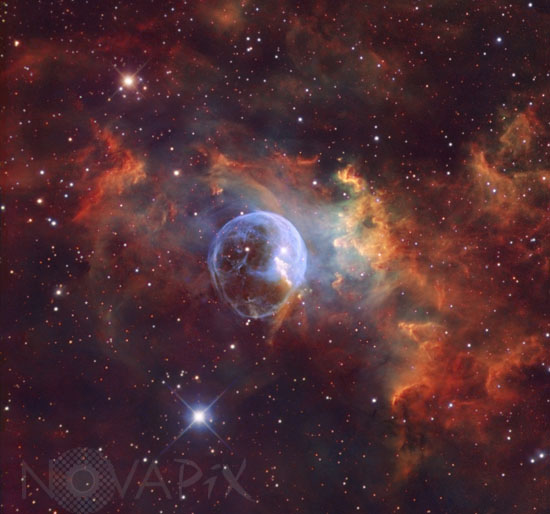Photo Agency - Astronomy - Space - Nature

The Bubble Nebula (NGC 7635) in Cassiopeia
author: R.Gendler/BYU/Novapix
reference: a-neb76-35015
Image Size 300 DPI: 14 * 13 cm
The Bubble Nebula (NGC 7635) (S162) Distance: 7800 Light Years. Imagine a star 40 times as massive and several hundred thousand times more luminous than our sun? BD +60°2522 is such a star. Its enormous energy output and powerful stellar winds have blown a titanic bubble of ionized gas measuring 6 light years in diameter. Popularly known as the Bubble Nebula, the strange symmetrically round nebula is the outcome of the prodigious energy output and fierce stellar winds of an unusually powerful star known as a Wolf-Rayet star. Named after the French astronomers Charles Wolf and Georges Rayet, who first described the unusual stars in 1867, less than 300 Wolf-Rayet stars (WR) have been identified in our own galaxy and some have even been identified in other galaxies. These extremely powerful stars mark the end stage of rare O type stars that begin their lives with at least 25 times the mass of our sun. WR stars can lose two thirds of their mass during this final stage of their stellar life. A star entering the WR stage with 35 solar masses can end up as a 10 solar mass star before it explodes as a supernova. Narrowband False Color composite (Hubble Palette) H-alpha, OIII, SII, RGB (stars).
Keywords for this photo:
2010 - ASTRONOMY - BUBBLE NEBULA - CASSIOPEIA - EMISSION NEBULA - EVOLUTION - FALSE COLOR - MASSIVE STAR - NEBULA - NGC 7635 - SII-Ha-OIII - STAR - WOLF-RAYET -
Contact : Stéphane Aubin +33-(0)9-51-26-53-76
© Novapix - All rights reserved


